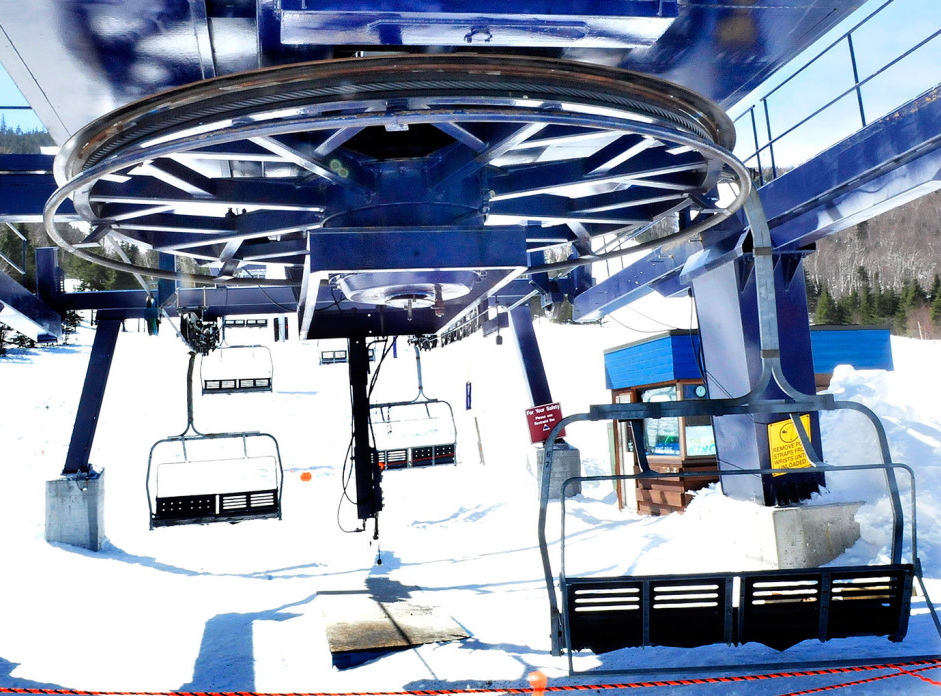Regulators in other skiing states moved Thursday to inspect lifts similar to the one at Sugarloaf Mountain Resort that malfunctioned Saturday, injuring seven people, and the company that services those lifts issued a bulletin alerting customers.
The drive shaft on the King Pine chairlift broke in such a way that the two primary braking systems didn’t work. As the lift loaded with about 240 skiers started to slide backward, a separate braking mechanism failed to drop into place to prevent the rollback.
Investigators determined Wednesday that a design flaw that has existed since the lift was installed in 1988 may have contributed to the “drop dog” not working as it should have, and that information spread quickly among the ski industry and state regulators outside of Maine, where 150 and 180 lifts of that type are in use.
Maine’s chief lift inspector returned to Sugarloaf on Thursday to continue the state’s probe into the mishap and a spokesman for the Maine Elevator and Tramway Safety Board said no information would be released until the investigation is complete.
The extreme fracture of the lift’s drive shaft, which transmits energy from the electric motor to the bullwheel that pulls the lift’s cable, was the primary cause of the malfunction, Sugarloaf has said. Inspectors and engineers say such a breakdown is rare and difficult to diagnose before it happens.
When the shaft broke, there initially was nothing preventing the chairlift from sliding backward and picking up speed. A caliper brake, much like the disc brakes on a car, was quickly applied and stopped the lift after it had traveled 460 feet.
But a backstop device called a drop dog didn’t work. It is basically a bar of metal designed to fall into place when the lift slows to a certain speed. As long as the bullwheel is moving forward at high speed, a switch keeps the drop dog from engaging. If the wheel starts to go in reverse, the drop dog is supposed to drop and wedge against one of the cogs in the bullwheel to stop it.
That didn’t happen Saturday and investigators believe the switch that raises the drop dog when the bullwheel is spinning forward rapidly also raises it when it is spinning rapidly in reverse. Sugarloaf officials said a minor modification to the switch wiring fixed the problem, and the repair was made Wednesday on six other lifts.
Ethan Austin, spokesman for Sugarloaf, said the lift that malfunctioned Saturday went almost instantaneously from full-speed forward to full-speed reverse.
“When the drive shaft broke, the lift was able to pick up speed so quickly in the reverse direction, it engaged the switch and raised the drop dog,” Austin said. He said the resort’s test of the mechanism can’t simulate such a scenario.
REACTION ELSEWHERE
Briggs Lockwood, head of chairlift inspections in New Hampshire, which has 26 ski areas with 161 lifts, said the switch design wasn’t a surprise, but his inspectors still went out Wednesday and Thursday to check six lifts manufactured by the same company, Borvig, and planned to inspect another two Friday. Others are not currently operating.
“I understand there is some uneasiness with the switch, as it picks up the dog if it rotates in either direction. We have been aware of this,” Lockwood said. He said that if the switch is adjusted properly, it should not be a problem.
That device has passed tests with fully loaded and moving lifts, which are required every seven years, he said, though he expects the New Hampshire Passenger Tramway Safety Board will discuss it. The device is not intended to stop the bullwheel when it is spinning fast – which would damage equipment – but only to keep it from slipping backward once it is stopped.
In Vermont, Stephen Monahan, head of the Passenger Tramway Program, said his state inspectors had been tracking developments at Sugarloaf. They checked out two ski areas with lifts similar to King Pine and both had a different type of backstop device. A similar lift at another area is being taken out of service because the season is ending and it will be retrofitted before it returns to service, he said.
Monahan said the issue is likely to be more acute in the Northeast because western ski areas are relatively new or have invested heavily in upgrading their lifts.
Borvig is no longer in business, but parts and service for its lifts are provided by Partek Ski Lifts. A telephone message and email seeking comment from the company were not returned Thursday.
The Partek service bulletin issued Thursday does not shed light on what might have happened. The bulletin, from Partek president Hagen Schulz, said that operators should make sure the backstop components are installed and functioning properly before each day’s use and that attendants should notify a supervisor of any problems.
The bulletin also says operators should make sure the caliper brake system is working as intended.
Owners receiving the bulletin are required to notify authorities having jurisdiction over lifts, it says.
Send questions/comments to the editors.



Success. Please wait for the page to reload. If the page does not reload within 5 seconds, please refresh the page.
Enter your email and password to access comments.
Hi, to comment on stories you must . This profile is in addition to your subscription and website login.
Already have a commenting profile? .
Invalid username/password.
Please check your email to confirm and complete your registration.
Only subscribers are eligible to post comments. Please subscribe or login first for digital access. Here’s why.
Use the form below to reset your password. When you've submitted your account email, we will send an email with a reset code.